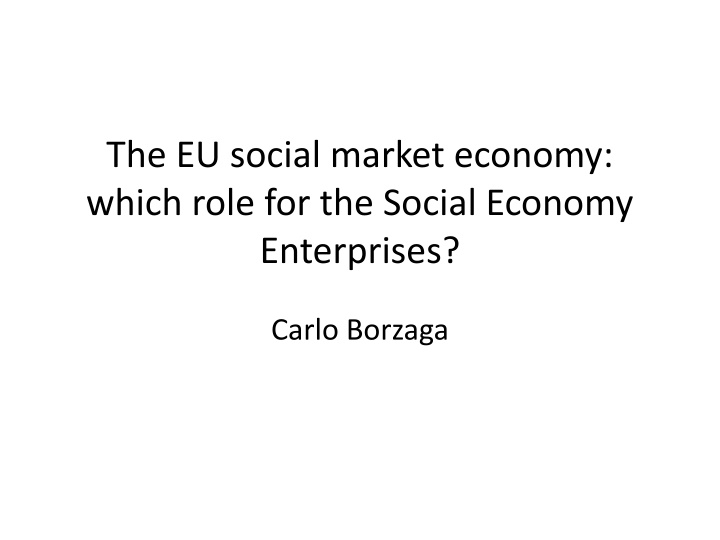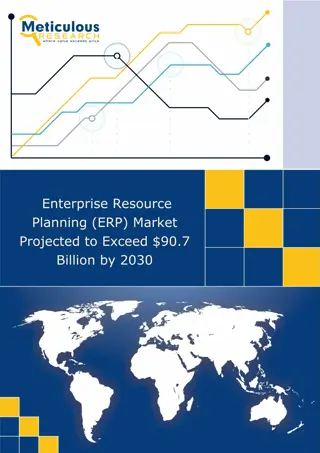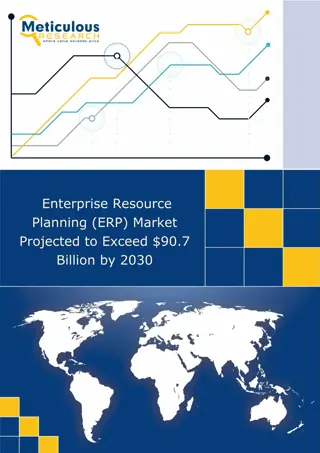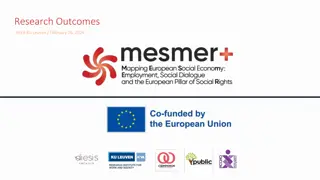The Role of Social Economy Enterprises in the EU Social Market Economy
Social Economy Enterprises play a crucial role in the European Social Market Economy, balancing economic objectives with social progress. Explore the differences between the Social Market Economy and Social Economy Enterprises, understanding their impact on European socio-economic models and the pursuit of community needs.
Download Presentation

Please find below an Image/Link to download the presentation.
The content on the website is provided AS IS for your information and personal use only. It may not be sold, licensed, or shared on other websites without obtaining consent from the author.If you encounter any issues during the download, it is possible that the publisher has removed the file from their server.
You are allowed to download the files provided on this website for personal or commercial use, subject to the condition that they are used lawfully. All files are the property of their respective owners.
The content on the website is provided AS IS for your information and personal use only. It may not be sold, licensed, or shared on other websites without obtaining consent from the author.
E N D
Presentation Transcript
The EU social market economy: which role for the Social Economy Enterprises? Carlo Borzaga
Introduction Social Market Economy and Social Economy (enterprises or organizations) seem very similar concepts having the word social in common. In reality, they are very different: in each of them the term "social" takes on a different meaning. The Social Market Economy is used to define the European socio-economic model: the term social refers to the social progress that can be achieved thanks to a well functioning free market economy. The Social (and solidarity) Economy (or Enterprises) refers to the heterogeneous set of organizations and companies whose main purpose is to respond to unmet needs of the community or of a group of citizens. The term social is used here to stress the fact that these organizations are different from conventional companies because they pursue simultaneously an economic and an social objective, with the first being subordinated (instrumental) to the second. Since the main aim of this keynote is to analyse the role of Social economy organizations and enterprises (SEOs and SEEs) in the European Social Market Economy (SME) we must start by defining the characteristics of both the SME and and the Social (and Solidarity) Economy (SSE)
The social market economy (SME) model (I) Implemented by the Federal Republic of Germany since 1948, the Social Market Economy has been adopted by the EU and it is now considered the social and economic model of the Union As such it: guides all the EU economic and social policies endeavouring to combine, on the basis of a competitive economy, private initiatives and social progress by seeking to strike a balance between free market and social welfare regulates markets with the main aim of safeguarding the protection of: consumers through competition workers social rights through trade unions and participation in the governance of enterprises making sure that social policies do not interfere with economic activity and the freedom of enterprise The SME model aspires to reconcile the apparently contradictory elements of a liberal market economy: self with public interest
The social market economy (SME) model (II) The SME is not clearly defined: its priorities and actions have evolved over time, reflecting the diverse influences of EU Member States and economic and social policies The most complete definition is the one resulting from both the Lisbon Treaty and the 2020 strategy. Based on it the EU aims to build a: highly competitive social market economy, aiming at full employment and social progress with the ultimate goal to secure smart, sustainable and inclusive growth (2020 strategy) When compared to the original German one, this definition sheds more light on the balance to be achieved between the free and undistorted competition and the strengthening of the social aspects of European integration: it is more focused on social aspects. However, it is not clear how the balance between the two aims ought to be ensured given the separation between the actors entrusted with the market regulation (the EU) and those responsible for social protection policies (the Member States) As a consequence, the SME is characterized by a structural tension between market integration and social value, which has increased as a result of: globalization, privatizations crisis of intermediary bodies (e.g. trade unions and demographic changes pressures to privatize public companies and services, to extend the competition to social services and to reform the labour market in a liberal sense austerity policies following the 2008 financial crisis
The Social economy (SE): main characteristics The main elements that distinguish SEOs or SEEs from conventional companies and public entities are not the legal forms they adopt or the social impact they generate, whatever this means but: the aim: fulfilling a need of a community or a defined group of people is the goal of SEEs, while for conventional companies the existence of a need is the condition to guarantee to the owners the opportunity to make a profitable investment the ownership/governance: ownership rights are assigned on an individual/person basis and not on the basis of the shares of capital owned; the rule one member one vote follows the logic followed in determining the distribution of costs and benefits: based on cooperative agreements rather than exchanges between self-interested agents through market or contracts the constraints self-assumed or imposed by the regulator: e.g., the obligation to allocate part of the profits to reserves, profit distribution constraints and asset lock; this last constraint makes the SEOs (including SEEs) a real common
Main outcomes of the SME Up to now the EU SME model has achieved controversial outcomes: positive in terms of consumer protection: policies and tools designed to safeguard competitiveness and to control mergers of enterprises have worked quite well (differently from the USA where policies ended up costing families up to 5,000 dollars per year - Thomas Philippon); until the end of last century, positive in combining economic and social aspects most recently, less positive in terms of social progress: social policies have progressively become complementary or ancillary to the priority of fostering economic growth (e.g. labour market reforms) the freedom of EU Member States in defining, implementing and financing social policies has been questioned by state aid regulations and by the imposition of public budget constraint the provision of social services has been subjected to competition law with declining attention being paid to the specificities of the providers
The traditional role of the SE in implementation of the SME Until the end of XX century, both SEOs and SEEs have contributed to consolidating the SME model at least in two ways: increasing competitiveness and improving consumers satisfaction by managing entrepreneurial activities with governance solutions for managing transactions otherwise (monopolistic or monopsonistic power, asymmetric information etc.); in general terms, the existence of operating on the same market, while pursuing different aims and being distinguished by diverse competitiveness and ends up benefiting consumers, especially in given sectors (banking, agriculture, consumption, welfare) pushing public authorities to encounter unmet needs of citizens, including needs of minority groups, through advocacy and pioneering subject to market failure diverse types of enterprises ownership forms, fosters
In search for a new equilibrium: the new roles of SEOs (I) Between the end of the past and the beginning of the new century, SEOs have started to play new roles: they contribute to reducing the growing tensions between market integration/regulation and social value/policies that characterize the SME model. In many countries, SEOs: have increased and often innovated the provision of a large spectrum of general interest/community services (from social services to the production of green power); have autonomously given rise and experimented with new legal forms and ownership/organizational models (social cooperatives, work integration social enterprises, etc.) have entered the public/academic debate (a growing number of researches and academic publications, programmes, etc.) and attracted attention from public institutions (as in the case of the Social Business Initiative) dedicated educational
In search for a a new equilibrium: the new roles of SEOs (II) Recent research corroborates that SEOs have become an autonomous player of the SME, which contributes to improving its functioning. However, EU official documents referring to the SME do not mention and do not clearly connect SEOs with the European socio-economic model SEOs and SEEs continue to be considered not really different from conventional businesses (e.g. debate on inclusive economy and social impact ) and not autonomous from the public policies Hence, emerges the need to clarify why and to what extent are SEOs different from the other private and public institutions.
SEOs versus conventional companies and public institutions Given their characteristics: differently from regular companies (for-profit) that focus only (or mainly) on economic outcomes, SSEs explicitly combine social with economic aspects, providing solutions to unmet needs in an economically sustainable manner; differently from public administrations and institutions, SEOs tackle social and economic concerns (often often detected directly in autonomy) by committing voluntarily and not because they obey to an authority private, human and financial resources, and combining but not necessarily - with public resources
The new contributions of SEOs In the new scenario characterized by increasing tension between the social and economic dimensions of the European social and economic model the contribution of SEOs is much wider as it includes: the contribution to new job creation especially in the general interest services sector and in favour of weak groups of citizens the contribution to reducing economic inequalities: SEEs tend to distribute more value to labour since maximising profit is not their goal the contribution to local development thanks to their ability to use community resources scarcely/not used (e.g., thanks to volunteers) and to operate in sectors with low profitability the contribution in facilitating the transition from informal to formal economy, since SSEs are better able to detect relevant needs and to address them efficiently the contribution to producing goods/services characterized by high positive externalities in a conscious and shared way additional to public provision Taken together these various contributions allow to state that SEEs help to increase the efficiency of the European economies, their employment creation capacity and the supply of social services
Main conclusions: what to do? SEE must be better recognized in the European official documents and policies and considered not as ancillary to the SME model but as a third and autonomous actor additional to the State and for profit enterprises The distinctive features of the diverse types of enterprises must be highlighted: it is important to stress that, independently from their domain of engagement, for profit enterprises must be distinguished from SEEs, even when they address social and/or environmental issues Since diversity matters, the diverse features of SEEs must be taken into account when policy measures -levelling the playing field or regulating the fiscal frameworks- are designed, either at EU or Member State levels To achieve full employment and social progress new forms of cooperation between SEEs, public and private actors must be sought since there are evidences that they work better than competition and obligation, especially in those domains that are socially sensible
Main conclusions: the issue of evaluation Concerning the growing emphasis on the evaluation of social impact , when SEEs are involved we must be aware that: - it is not social impact that defines SEEs, but their features (i.e. aim pursued and governance model); we must insist that one thing is what SEEs do and another thing is what conventional companies promise to do (i.e. the promise to go beyond profit maximization): confusion does not help - unlike for-profit enterprises, the social impact of a SEE is guaranteed first by its ownership, governance and related constraints - social impact can be measured only for well defined projects not for organizations - methodologies, tools and indicators for measuring social impact of for-profits must differ from those applied to SEEs























